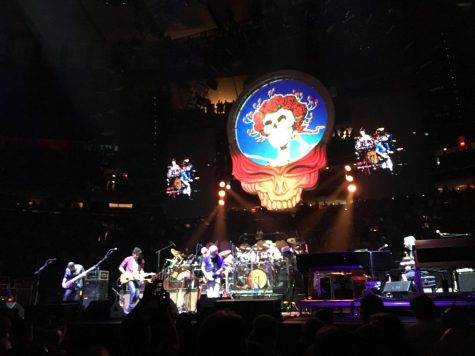Podcast: Grateful Dead Review: In Between a Wook and a Hard Place
Toby Yarrington and Hails Traficanti ’20 take a look at three decades of the Grateful Dead’s music in their podcast “In Between a Wook and A Hard Place” and examine the documentary “A Long Strange Trip.”
Review: Long Strange Trip Documentary
The Long Strange Trip is a documentary the follows the Grateful Dead throughout their years on
tour from 1965 – 1995. The film is aimed to better inform people on the journey of the band as
well as the life of Jerry Garcia, the front-man of the Dead, who died in 1995. The documentary is
broken up into six episodes and I decided to analyze the final episode. This particular installment
focuses on the final years of Jerry’s life and the last days of the band. There is a huge emphasis
on evaluating what drove Garcia over the edge towards the end of his life and seeing another
darker side of these final years. The documentary is directed by Amir Bar-Lev.
The film begins with explaining the state of the band in the late 80’s. They interview Phil
Lesh, Grateful Dead bassist, as well as other Dead archivists that describe the growing
unhealthiness of Jerry and how it affected the band as a whole. Jerry was being extremely
overrun for his severe diabetic condition and mid-way through summer tour in 1985, he became
dehydrated and went into a diabetic coma. The director makes sure to emphasize the weight and
pressure that Jerry was feeling leading up to this incident and puts a lot of the blame on the Dead
community as so many were putting their livelihood on him. It would have been easy to get
defensive about this as I would have fallen into the category he was holding responsible if I were
alive at that time, but I agree with this stance because everyone was simply putting way too
much on Jerry’s shoulders. They should have been helping him rather than depending on him to
perform. The interview takes he chose to put into this segment really made the fans the reason
that the band went through this dark period.
However, once Jerry woke up from the coma and relearned the guitar, he gained a sudden
burst of energy. This is displayed by his daughter Trixie as she describes him spending tons of
time with her, which he hadn’t before, writing music all of the time, and super happy all of the
time. What followed were four years of amazing shows, vibrant new songs, and exponential
growing popularity for the Dead everywhere they went. The released their best selling album
ever and were selling out massive stadiums and coliseums in every town. Because the Deadhead
community loves to reminisce about these times, it’s no surprise that the documentary has a very
light and happy feel to it during this portion. Some of the most popular and arguably best shows
came from this era.
Amir Bar-Lev chooses to make an abrupt dark shift for the final portion of the last
episode. This is due to Jerry beginning to use heroin again. This last third of the episode made
me extremely emotional and it was very hard to watch at times because of my attachment to the
band. The sadness of all of this is portrayed with an interview of Bridget, who was Jerry’s
girlfriend in the late 80’s and early 90’s. It is haunting to hear her retell those final years and how
Jerry slowly pushed her and everyone else he loved out of his life. The director tries his best to
emphasize that most of what happened to Jerry was his own choice and it’s the path that he
chose, but he also makes sure that the Dead community is also brought up as one of the driving
forces that pushed Garcia over the edge. There was so much pressure on him at this time that
there was no where for him to escape to. Even though this was a prevalent, band member’s
interviews also emphasize the point that knowing Jerry, he would have still kept on performing
no matter what with his self titled band, Jerry Garcia Band, even if the group was to take another
break.
Watching this documentary really helped me to look further into the story of the Dead,
especially their, often looked over, conclusion to their years together. I fully agree with every
stance that the director took on these issues as he was sure to include multiple sides to each story
and reasoning behind each one. There was more to blame than just heroin with Jerry’s death.
There were intricate pressures and harsh dependencies that caused such a beloved icon to
collapse. As a Deadhead, I can take some responsibility in knowing that if I was alive back then,
I might not have been able to see these signs and maybe I would have been too dependent on
him. But I can also accept that this fate was probably going to come one way or another and I
can be happy that Jerry was able to give us the music that he did for as long as he could.
Act I-It’s Alive
The first episode begins with the history of Jerry Garcia and how his childhood was
based around music. He loved music as a child and began playing the five string banjo when he
was a teenager. Bluegrass music was something that connected him to the world around him.
Living in San Francisco in the late 1960’s was interesting because the counter culture movement
was in full swing. Garcia started a band called Mother Mcree’s Uptown Jug Champions with
rhythm guitarist Bob Weir and blues harmonica player Ron ‘Pigpen’ Mckernan. However, the
band decided to “plug in” and add members Phil Lesh on bass and Bill Kreutzmann on the
drums. Soon after, the band became involved in a movement known by many as the Acid Tests.
This movement, taking charge in counterculture, sought to advocate and allow free use of the
drug LSD, which at the time was not illegal. The Warlocks would sometimes play for upwards of
seven hours, and they would also sometimes only play two notes and be done. They had no
obligation to play music, they just played because they loved it. Through 1966 and into 1967, the
band figured out that they needed a new name, because another band already had the name “The
Warlocks.” The story goes that Jerry opened a dictionary, and the first thing that he saw was the
term “The Grateful Dead.” There it was, the birth of the band.
Act II- This Is Now
The band begins releasing more music and eventually sign with Warner Brothers in
October of 1966. They began touring and went on their first European tour in 1967. The record
label was only concerned about making money off of records however, and the Dead at that
point were not willing to make a record that was conducive to making a lot of money. The first
album was called Aoxomoxoa, and it was definitely not what Warner Brothers thought of as a
top selling album. As they continued playing, they soon decided to hire a tour manager because
they had no idea how to actually make money in the music industry. Jerry was fascinated with
how the Rolling Stones organized their tours because they were such an organized band. The
band soon moved out of San Francisco because there was significantly more tourism than how it
used to be. Soon after, they began to experiment with the sound of the band and decided to make
a record “the easy way.” This is when Working Man’s Dead and American Beauty were made.
These two albums were absolute hits and skyrocketed the dead into the 1970’s.
Act III- Let’s Go Get In The Band
The band gains two new members, keyboardist Keith Godchaux and backup singer
Donna Jean Godchaux. There were so many people who originally were fans and then got into
the inner circle with the band either by joining the band or being a part of the equipment crew.
The whole crew and band were one big family. As the Europe 72’ tour began, the band was
officially hitting their stride. LSD was a significant part of the entire crew’s lifestyle now, and
they were taking it every day. As the Dead prepared another album for release, they decided to
create the album in culmination of the legendary tour. John Barlow, Weir’s lyricist then talks
about some of the pitfalls of the band and how there was no place for emotion. Pigpen was an
essential part of the band and he was in many ways the life of the band. However, he was a Blues
musician, and he had trouble branching out of these genre. Moreover, Pigpen was an alcoholic,
so he did not like experimenting with psychedelic drugs. This sort of ousted him from the band
because he did not like when things got weird and everyone was using psychedelic drugs. He
eventually died from alcoholism, which was a huge turning point for the band.
Act IV- Who’s In Charge Here?
The band discusses how through the Acid Tests and the use of psychedelic drugs, they
learned that anything is possible and there are no limits when it comes to music. The crew
learned how to weld and created this PA system called the wall of sound. At the heart of this
system was a man named Oustley Stanley was a famous LSD chemist but also the Dead’s lead
sound engineer. His dream was to create a sound system that you could hear from a mile away.
The system took four hours to set up and four hours to take down, so it was an absolute
nightmare for the crew. They had no time to sleep because the system was a logistical nightmare.
Jerry did not want any one person to be in charge, and this became an issue because they could
not make any business decisions. The band also got in to harder drugs like cocaine and heroin,
which lead to significant issues as well. There was a lot of evil in the world of the band,
especially when the Hell’s Angels started to hang out with the band a lot. Jerry then hired the
Hells Angels to be security at the Altamont Freeway, and someone was murdered there which
caused a lot of controversy. Garcia had a strong belief that the band should be leaderless, even
though he was the clear leader of the band. Nobody wanted to be in charge, and nobody wanted
to make any decisions. Too much was happening too fast, so everyone came to the decision that
the band should take a break.
Act V- Dead Heads
The dead heads are the fans of the Grateful Dead and they are considered to be some of
the most faithful fans in the history of music. It is truly remarkable how the band was able to
transcend through four decades and be significant and have a presence in each of them. Through
the 1980’s, Ronald Reagan became president and he basically ran against the 1960’s. The Dead
and the dead heads were the only people who were still actively taking part in the counterculture
movement. One of the main things that draws people to the Grateful Dead is how beautiful the
scene is and also how amazing the improvisation is live. Another thing that makes the Grateful
Dead special is the way that they let everyone record their shows. This ended up being the best
business decision in the history of music because they made all of their money on tickets instead
of records. Moreover, the band brought in Brent Mydland as the new keyboard player. He
brought a brand new style of piano playing to the band, and was a fabulous singer. The fans then
discuss the amazing style of a Grateful Dead show and how no other band can compare to it.
Robert Hunter was an amazing lyricist and he wrote a lot of the Grateful Dead’s songs with
Jerry. Some of the most amazing lyrics ever written were from Robert Hunter.
Act VI- It Becomes Everything
Jerry discusses how he was actually scared for the first eighteen years because of the
power of the band. He knew that if he tried to control this power then it would become too much,
but he never would want to be in a position of power. A journalist also talks about how while
Jerry was lifting other people’s burdens, his health was declining rapidly. He became so
unhealthy that he actually went into a diabetic coma in 1985. This was significant because he
realized that he was not only not afraid of death, but also that he wanted to accomplish a lot in
his life still. A big part of the culture of the dead is how they are okay with everyone loving their
music. Moreover, the environment became so hectic that there would be more people outside of
the show than inside. It got so bad that many venues would not let the band play because of how
many people were dying at shows. Jerry did not like talking to the audience because they would
hang on to every word that he said. It became so overwhelming to him because he became
almost a messiah figure. The sad thing was that in a community as loving and amazing as the
dead community was, Jerry was isolated. After Brent Midland died in 1990 from a heroin
overdose, Jerry wanted a way out. Through 1995, Jerry became old and frail and truly wanted to
be done at that point. Ironically, Jerry Garcia wanted The Grateful Dead to be something that
was constantly flowing and dynamic and something that was never set in stone. In doing this, he
created essentially a machine that will last throughout time.
Podcast: Grateful Dead Review: In Between a Wook and a Hard Place







